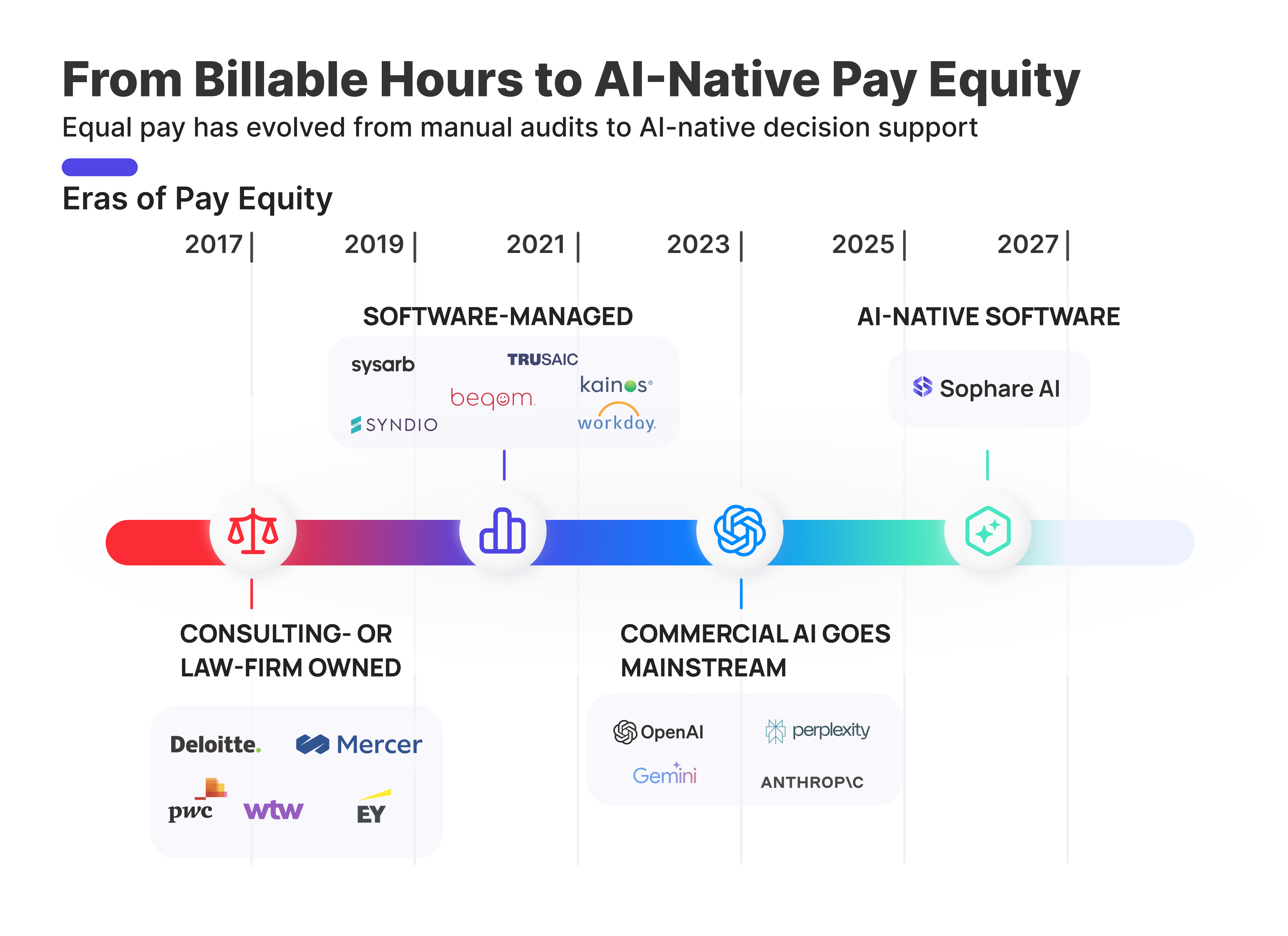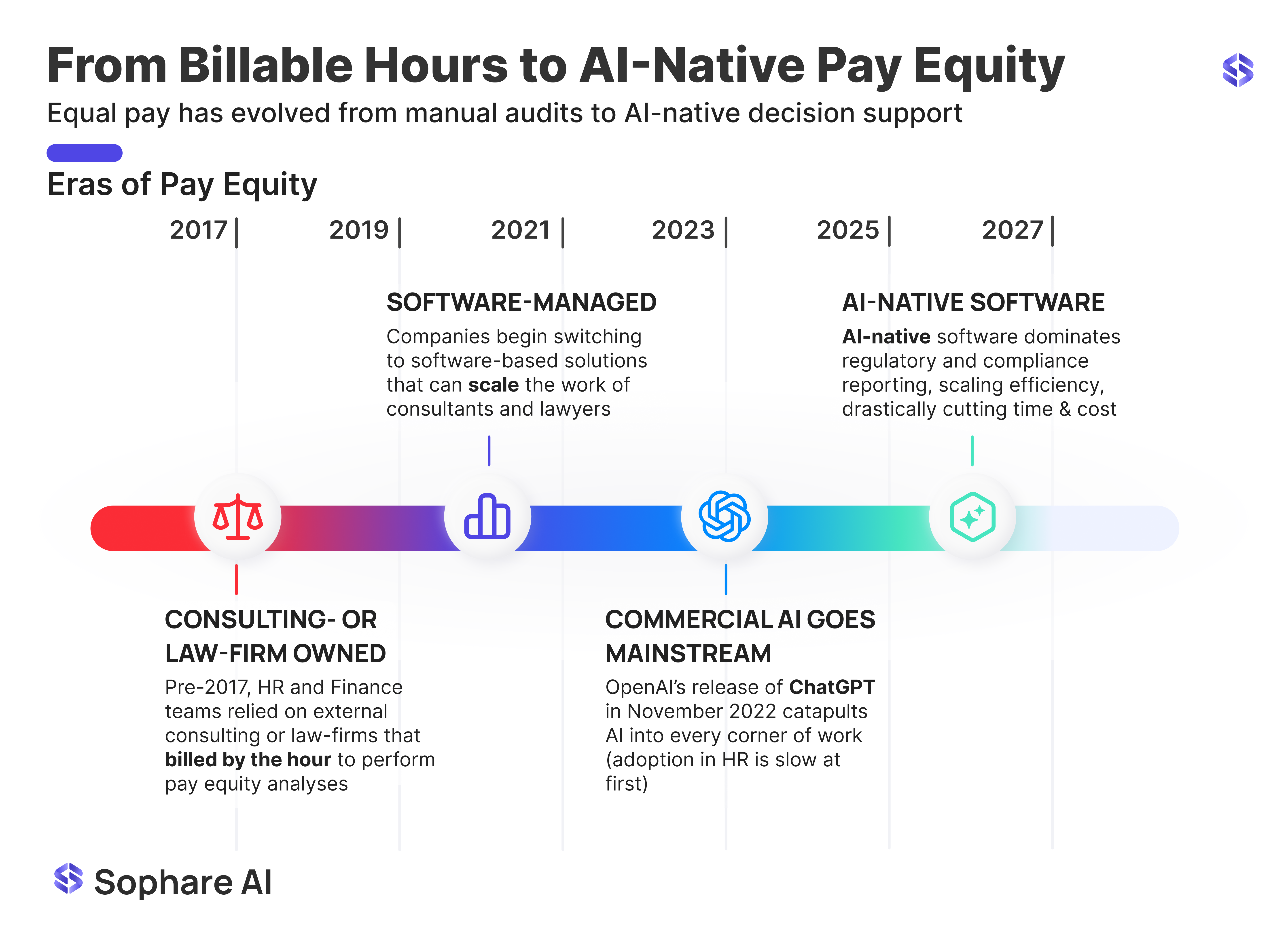From Billable Hours to AI-Native Pay Equity: What HR Leaders Need to Know
Why pay equity is on every CHRO’s agenda in 2025
Equal pay is the legal principle that individuals doing the same, similar, or “equal value” work must be paid the same regardless of gender, race or other protected categories. What started because of labour activism in the 1960s and 70s became codified into law as equal pay acts emerged in various countries.
Today, pay equity is directly related to regulation, investor scrutiny, and workforce confidence. Companies with employees in multiple countries (or US states) need to adhere to multiple laws and reporting requirements when it comes to calculating equal pay for equal work and reporting on pay gaps. Failure to do so is an extremely expensive affair and most internal HR teams have neither the staff nor the bandwidth to do this work in-house.

How pay equity work used to get done
The consultant/law firm era (1990s → 2010s)
Through the 1990s–2010s, pay equity reviews were typically consultant or lawyer led projects:
- Data wrangling and modeling by economists/statisticians: Multiple regression models to control for role, level, tenure, location, etc., then test whether gender (or race/ethnicity) remains significant
- Run under legal privilege: Many employers engaged outside counsel to direct audits to preserve attorney-client privilege (especially in the US)
- Periodic, manual: HR or reward teams compiled data once a year (or before litigation), outside experts ran analyses, and companies made one-off pay adjustments. Practitioner playbooks from law firms and SHRM reflect this cadence
- High touch, tedious, expensive: Multiple external experts touched the dataset from entry level analysts all the way to partners who reviewed the calculations. This resulted in a slow, tedious and expensive process as high billable hours for each project were passed on to the customers
- Primitive tooling: Lawyers and consultants relied on spreadsheets and Excel. Static files left little room for testing, iteration, or flexible scenario planning
The software era (late-2010s → early-2020s)
As reporting rules and scrutiny grew, specialist software emerged to operationalize pay equity:
- Software calculates static HR pay gaps: Vendors productized regression, remediation budgeting, and audit trails shifting from annual projects to as needed analysis
- HR Data clean up: Most vendors did not automate like-for-like or equal work groupings and still expected the HR data or employment legal teams to do this data clean up work for them
- Some companies did this in-house: Salesforce famously ran repeated audits and spent millions correcting discrepancies, illustrating the move from episodic to programmatic remediation
Our founder Siena Duplan has a background in data science and machine learning applied to HR. At Salesforce, Duplan led the development of pay equity algorithms, which highlighted the shortcomings of legacy B2B SaaS approaches. Sophare is the leading AI-native platform for pay transparency and pay equity that replaces outdated B2B SaaS models.
The AI era (2025 → now)
Today’s tools layer AI and traditional machine learning (ML) models onto statistics to make pay equity proactive and embedded:
- Decision support inside pay cycles: Platforms now suggest targeted adjustments to maximize compliance ROI and guide candidate offer decisions in real-time
- API connected: HR data teams are no longer expected to pull the raw data and send it to the software vendors’ portal
- Compliance by design: EU’s Directive 2023/970 plus UK reporting push software to produce audit-ready documentation, explainability, and “joint pay assessment” workflows when 5% thresholds are tripped
- Adjacent AI trends in comp: AI is increasingly used for pay benchmarking and reward design—useful, but still needs human oversight to avoid bias amplification
- Limits: Generative AI alone is not sufficient for pay equity modeling. Current LLMs are not designed to identify groups performing equal work within a dataset or to explain the drivers of a pay gap. Effective analysis still requires either a purpose-built compensation model or human expertise

What is the future of AI-native pay equity tools?
The next wave of pay equity platforms goes beyond periodic analysis. AI-native tools are being designed to embed equity considerations directly into everyday decision-making, automate compliance, and surface insights in real-time. Platform capabilities are expanding in several key areas:
- Continuous monitoring: Real-time scanning of HR and payroll data
- Decision support: Risk signals embedded in pay reviews and promotions guide HR and people managers during pay review, promotions, or offers—not just after the fact
- Audit-ready outputs: Reports aligned to US state regulations, UK, EU, and APAC compliance requirements
- Intersectional analysis: Capability to assess multiple demographics where lawful
- Scenario modelling: Budget forecasting for remediation before decisions are final
How companies typically do it now (a practical arc)
Most large organizations follow a standard sequence when tackling pay equity. The process usually begins with preparing the data and ends with public reporting, with several important steps in between:
- Data readiness: clean job architecture; consistent levels
- Baseline analysis: regression; intersectional cuts
- Remediation planning: targeted increases; guardrails
- Policy fixes: range hygiene, promotion & hiring controls
- Continuous monitoring: dashboards; audit logs; explainable models
- Public reporting & joint assessments: codified flow in most modern platforms and guidance
Looking ahead
Pay equity has shifted from a yearly checkpoint to a continuous business practice. With the right AI-native tool, organizations can stay compliant, build trust, retain talent, and make smarter pay decisions every day. At Sophare, we’re proving that the most advanced approach to pay equity can also be the most cost-effective, delivering outsized impact without legacy price tags.
